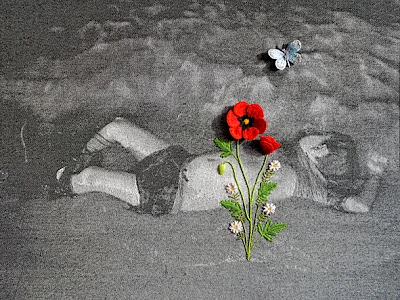Where Flowers bloom
| Year: | 2018 |
| City: | Vienna, Austria |
| Measures: | 4 pieces, 42 x 32 cm each |
| Media: | Stumpwork on woven cloth |
| Exhibitions: | |
| Catalogues: |
The language of flowers, sometimes called floriography, is a means of secret communication through the use of flowers. Here, these are embroidered on woven photos of drowned refugee children in three-dimensional stumpwork, a technique that had its heyday in England during the 17th century.
Yet, the gravity of the message transcends the delicacy of the floral motifs. Each petal and bloom contributes to a narrative that unveils a tragic reality—the woven photos depict drowned refugee children. The juxtaposition of beauty and sorrow, achieved through the meticulous craft of stumpwork, serves as a powerful commentary on the human condition.
Stumpwork, with its raised and sculptural quality, adds a tangible depth to the scenes captured in the woven photographs. The technique, involving padding and various stitching methods, creates a tactile 3d experience that draws viewers into the intricate details of the composition. The choice of stumpwork as a medium not only pays homage to historical craftsmanship but also amplifies the emotional impact of the subject matter.
Each carefully chosen bloom and arrangement becomes a symbolic element, conveying an unspoken message about the plight of refugees and the collective human responsibility to address these heartbreaking realities. Boukal's use of floriography within the framework of stumpwork elevates the conversation, inviting viewers to reflect on the deeper, often overlooked, aspects of the human experience.
In "Where Flowers Bloom," Tanja Boukal masterfully combines historical embroidery techniques with a contemporary and socially conscious narrative, urging us to contemplate the fragility of life and the potential for empathy and action.
The Meaning of the Flowers
| Floreography of each flower PDF, 1.1 MB |











